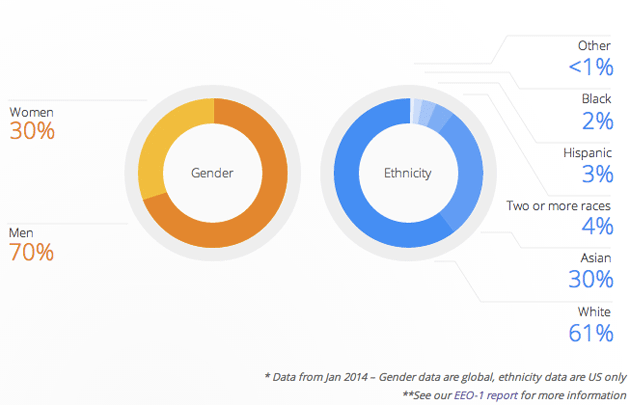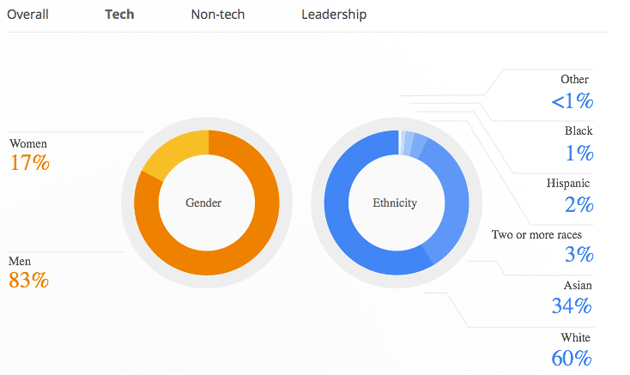
After stalling for years, Google finally released data on the diversity of its workforce Wednesday, admitting that the company is “miles from where want to be.” Lazlo Bock, Google’s senior vice president of people operations, noted that “being totally clear about the extent of the problem is a really important part of the solution,” adding that the company is supporting code education among historically underrepresented groups.
But those efforts may not be enough. Exclusive data obtained from the Labor Department by Mother Jones shows that top Silicon Valley tech firms lag far behind the general population in diversity, and that while Google is average in its recruitment of women, it has even fewer African-American and Latino employees than other major tech firms.
Google is far from the only Silicon Valley firm that has been tight-lipped about its demographics. Though large companies are legally obligated to report race and gender stats to the federal government, tech firms such as Google, Apple, and Oracle long ago convinced the Labor Department to treat the data as a “trade secret” and withhold it from the public. Mike Swift of the San Jose Mercury News sued the department to get the numbers. In 2010, following a two-year legal battle, he ultimately settled for stats for a handful of the Valley’s largest companies.
Swift’s data went through 2005. To get an update, I filed a Freedom of Information Act request a few months ago asking the Labor Department for its latest race and gender data on the top 10 firms. In order of largest to smallest by market capitalization, it now consists of Apple, Google, Oracle, Cisco Systems, Intel, Gilead Sciences, eBay, Facebook, Hewlett-Packard, and VMware. When I reached out for comment, most of these companies didn’t get back to me. Google responded that it intended to make its stats public, as it now has. The chart up top shows stats for Google’s workforce overall. The nontech workforce is a lot more balanced. But when you look at just the tech jobs, things are far less diverse. For example, 83 percent of the tech jobs are held by men, and 94 percent of those workers are white or Asian.

The data I obtained shows that Silicon Valley’s race and gender disparities also are wider when limited to executives and top managers, and more dramatic when compared to the makeup of the state workforce. Google’s stats reflect the same: Its “leadership” is 79 percent male and 72 percent white, which would put it a bit ahead of its peers, except that the report is vague about which specific positions are being included. Here’s what things look like for the Valley’s Top 10 firms, based on our Labor Department data:
The data obtained by Mother Jones illustrates that “many companies pay lip service to diversity rather than making the real changes,” says Telle Whitney, president and CEO of the Anita Borg Institute, a Palo Alto-based nonprofit that promotes the recruitment and retention of women in technology.
Though the technology gender gap originates in college—only about 18 percent of computer science graduates are women—Whitney believes that the imbalance ultimately stems from the failure of Silicon Valley’s leaders to groom more women for top positions, which in turn discourages younger women from entering the field. “First it has to be a priority to have a diverse workforce,” she says. “And the priority has to come from the top.”
Not all of a tech firm’s employees work as coders or engineers. But among those people directly employed in technology positions at Bay Area tech firms, Asians have actually surpassed whites as the dominant racial group:
These numbers are driven, in part, by the heavy reliance of tech companies on the H-1B visa program, which allows US firms to import up to 65,000 foreign workers each year to fill jobs that require “specialized knowledge.” In 2012, more than 40 percent of the H-1B workers in the United States came from India, China, or South Korea. Many of them earn less money for comparable jobs than their American counterparts, which is perhaps one reason why major tech firms have lobbied furiously in Washington to increase the H-1B visa cap.
But Asian Americans are also represented at a high rate in Silicon Valley, and are overrepresented among high school students taking the AP computer science exam:
Prominent techies like to say that the Valley is a pure meritocracy, but the glaring disparities make that a dubious claim. “In polite company, I would say it’s a fallacy,” says Laura Weidman Powers, the executive director of Code2040, a San Francisco-based nonprofit that promotes racial diversity in tech hiring. “In impolite company, I would say it’s bullshit.”
Powers doesn’t think tech corporate leaders are discriminating deliberately; the factors working against black and Latino candidates are more subtle and structural. “Referrals are a huge source of inbound talent for these companies, even when you look at a company as large as a Google or a Facebook,” Powers notes. Given that most Americans run in the social networks of people who look like them, the system benefits the Valley’s dominant groups at the expense of those on the outside.
Code2040 tries to disrupt that dynamic by actively recruiting talented African American and Latino computer science graduates and plugging them into internships at tech companies. But the group still struggles to convince CEOs to make diversity a goal. “For the tech industry, this is newer,” she says. “There is a pretty pervasive mindset of ‘Oh, we’re colorblind. We just see talent.'”
The best case for increasing diversity in Silicon Valley may be financial. Powers’ group gets its name from the year 2040, when people of color are expected to make up the majority of the US population. She argues that tech firms need to hire more people who reflect and understand their customer base. “For any company that has a consumer-facing product” a few years from now, she says, “the communities that use that product will look different.”
Correction: A previous version of this post included a chart showing diversity at Silicon Valley’s top 10 companies in 1999 vs 2012. There was a misinterpretation about one of the datasets used for the chart, so we have since removed it. In addition, the article has been amended to address Google’s breakdown according to tech and nontech jobs, and “leadership” positions.

















